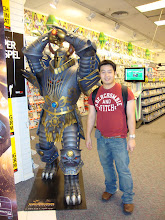During my holiday to Malaysia in May, I stopped by my wife, Michelle's hometown for a couple of weeks and eventually bought my Yonex Ti-10 racquet at a local badminton club there. The racquet that I bought was the last one available in the shop as Yonex was already superseding it with the newner, Gen III model.

I paid RM 450 (approx. £75) for this racquet and the shopkeeper threw in a Yonex bag, set of overgrips and BG-6 strings free. Pretty good bargain, I'd say.

I told the shopkeeper to string the racquet at 24lbs, which is the sort of tension I'm used to, but the Ti-10 can, apparently, take up to 30lbs! This strength can be attributed to the usage of titanium mesh in the frame and also the Muscle Power frame shape of the head.
Yonex says on their website that the rounded grommet holes in its Muscle Power frames eliminate stress-loading and fatigue of the string through contact friction, creating unity of frame and string through closer and tighter contact, and delivering more face stability packs power into hits.

Titanium mesh is the main ingredient in the frame. The technology's main benefit, according to Yonex, are a stronger and heavier fibre mesh, giving greater resistance to twisting forces generated on impact and mass-stablized frame. I think what this boils down to is a more stable racquet head.

Near high-end Yonex racquets like the Ti-10 are still produced in Japan. The shaft is made from high modulus graphite, which isn't a very dissimmiliar material found in modern racquets. High modulus, based on my engineering knowledge, means the material can absorb a high amount of bending forces before yielding.
This element is quite important in a racquet shaft to prevent buckling of the shaft due to the compression forces generated from lateral forces at the head.

Graduating from the Carbonex 8 to the Ti-10 isn't as scary a process as I had imagined.
It is a much lighter racquet and thus, very mobile and fast for defensive play, especially during a game of doubles. Probably why the Malaysian doubles team, Koo Keng Kiat and Tan Boon Heong chose the Ti-10 as their main racquet. Fu Haifeng of China is also another shuttler who uses this racquet.
Clearing is very near effortless, and drop shots can be executed very precisely. Being 'head-light balance', the racquet also takes less energy to manouvre around.
However, I found that my racquet's repulsion power is uncomfortably high for my liking. It could be the strings thats too tense but I have yet to find the real cause. When I do an offensive clear (low and fast clear to the baseline), the shuttle quite often goes out of the court. I guess, on the flip side of the coin, I can clear from baseline to baseline with less effort now. :D
At the net, the repulsion is also a problem for me occasionally. Shuttles tend to jump too high when I try to lob it over the net, even without much effort from my wrist. I just hope this is because I've used a heavy racquet in the past and easily overcome when I spend more court time with the racquet.
Now comes the interesting part: smashing power. Despite the high repulsion power, the smash power wasn't as great as I had imagined it to be. Yes, it definitely packs more punch than my old Carbonex 8 but comparatively, both the old Gen 1 Ti-10 and my wife's Ti-8 have greater smashing power than this racquet.
To conclude, I think this Yonex Ti-10 is a decent investment, considering the fact that I have not owned any racquets previously. If you are a smash maniac, then there are better racquets around but if you're looking a fast and nimble racquet for doubles play with decent killing power, then nothing else comes close (except maybe the Armortec 700 Technique).
Vital statistics
Price: RM 450 (discounted 2008 price)
Frame: HM Graphite + Titanium mesh
Shaft: HM Graphite
Stiffness: Extra stiff
Balance: Light head balance
Weight: 85 - 89 grams














